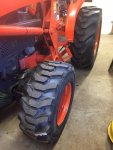HighMoon
New member
Equipment
L5740, 854 Loader, LandPride Gapple, Maschio Tiller, New Holland Flail Mower, et
In the past, as a non-member of this forum, I had browsed a number of posts on replacing tractor tires with something other than what Kubota offers. It seemed there was mixed success with some posts. I wanted to share my successful replacement of stock Kubota OEM Titan R4s with something different and what I learned in the process. First, a bit about why I was replacing them and why I wanted something different. Then I will summarize what I learned.
My Upper Michigan tree farm is in a remote area. I need to keep my tractor and implements as fit as possible because downtime is magnified for me by the distance I am from any tractor servicer. If I have a problem that requires getting the tractor into a shop I am looking at over three hundred miles round trip.
This past summer I had a front wheel fail (rim collapse due to internal corrosion). 2 weeks downtime. I decided this winter to tear off wheels and take off the tires to assess the others, which were all 12 years old. Prior to tearing them off I had noticed ballast leakage through sidewall cracks on the rear. Also, I had concerns with the OEM-sized tires. My farm has a lot of black spruce swamp on the margins and I routinely work in very soft ground. Larger front tire contact area would be especially helpful when clearing with the loader-grapple. I also wanted to improve traction so I could better push slashing piles and pull trees in soft areas.
What I learned:
My Upper Michigan tree farm is in a remote area. I need to keep my tractor and implements as fit as possible because downtime is magnified for me by the distance I am from any tractor servicer. If I have a problem that requires getting the tractor into a shop I am looking at over three hundred miles round trip.
This past summer I had a front wheel fail (rim collapse due to internal corrosion). 2 weeks downtime. I decided this winter to tear off wheels and take off the tires to assess the others, which were all 12 years old. Prior to tearing them off I had noticed ballast leakage through sidewall cracks on the rear. Also, I had concerns with the OEM-sized tires. My farm has a lot of black spruce swamp on the margins and I routinely work in very soft ground. Larger front tire contact area would be especially helpful when clearing with the loader-grapple. I also wanted to improve traction so I could better push slashing piles and pull trees in soft areas.
What I learned:
- Expect little help from Kubota if you want something different than what they offer. I called two dealers and Kubota USA. Those calls were a frustrating waste of my time. I didn't get much confidence that they knew much of anything about tractor tires or cared about my application. They couldn't tell me what brand tires I would get when they where quoting me what they had to offer. To them it was just another part number in the computer.
- I wasn't going to get the trans-axle ratio specs from Kubota. The best I could do was to approximate that from the static loaded radius of the OEM tires.
- A farm-dedicated tire servicer is a great place to go instead of your Kubota dealer. In contrast to my experience with Kubota, I found ag tire service dealers really know their stuff. They actually wanted to understand my application and with me explore the options that may better meet my needs.
- The ag tire servicer I worked with covers farms for the whole State of Wisconsin. His location was the nearest to my Michigan farm location. He explained that most farm tractor equipment dealers like Kubota and Deere don't want to mess with the tires. Many of them outsource their tire jobs to guys like him even when it is only the OEM-spec replacements being put on the tractor. He said they typically shy away from out-of-spec tire applications. Tractor equipment dealers put a markup on the tire replacement outsourcing.
- The ag tire servicer told me their experience has been that if you can keep the front-to-rear static load radius ratio within 2% of the original OEM-spec tires you will not have transfer case problems when moving to different sized tires. In my case, moving up my front tire size to the next size up (from 10-16.5 to 12-16.5 R4s) required also moving up the size of the rear tires (from 17.5-24 to 19.5-24).
- Tire contact profile, not just size, is also a consideration. For my application a full flat contact front tire profile combined with a ~70% flat contact rear tire was recommended to allow better front end support and maintain turning ease on all surfaces.
- The new tires were: Front - Galaxy R4 Muddy Buddy 12-16.5; Rear - Michelin Power CL 500/70-24 (19.5-24). The front tires required moving to a 9.75" rim width (from 8.25" standard) with a bit more offset to avoid interference with the front axle steering link guards.
- By working with the ag tire servicer I saved some $ outlay. I spent $1200 less than the quote I had from Kubota for OEM-sized replacements.
- The new set of tires have worked great since the installation. Very happy I didn't stick with Kubota and their limited offering.
Attachments
-
293.1 KB Views: 585
Last edited:


